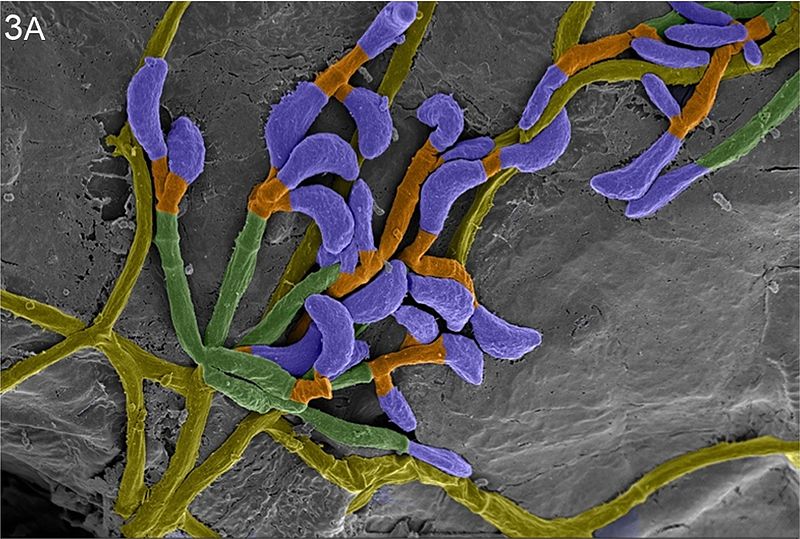LRMoore, Univ of Southern Maine
A Microbial Biorealm page on the genus LRMoore, Univ of Southern Maine
Classification
Higher order taxa
Domain; Phylum; Class; Order; family [Others may be used. Use NCBI link to find]
Species
Genus species
Description and significance
Describe the appearance, habitat, etc. of the organism, and why you think it is important.
Genome structure
Describe the size and content of the genome. How many chromosomes? Circular or linear? Other interesting features? What is known about its sequence?
Cell and colony structure
Interesting features of cell structure. Interesting features of colony structure.
Metabolism
Energy source(s); external electron donor(s) (=reductant source(s)); carbon source(s); oxygen classification; important molecules it produces.
Ecology
B. recurrentis is known for its inhabitance in human hosts and has only successfully been able to infect primates.
Pathology
These spirochaetes normally cause a blood infection but they can also infect the nervous system along with other tissues [5]. There are no known virulence factors, but there are a few novel ways that this sneaky pathogen evades the host immune system [5]. The body has its way of recognizing and enhancing the recognition of foreign invaders called opsonization, which targets them for destruction through a cascade of reactions known as the complement system. Recent studies show that B. recurrentis expresses a multifunctional surface lipoprotein, termed HcpA, that exploits the host’s proteins and offers resistance to complement attack and opsonization while increasing the potential to invade the host’s tissues [6]. Since HcpA outlines the high virulence potential of B. recurrentis, it makes a good target for therapeutic treatment of LBRF, however, none have been created yet. It was also found that this spirochete binds to the PLG(human plasminogen/Plasmin) receptor on endothelium cells and exploits their increased proteolytic capacity to breach tight junctions of endothelium, cross basement membranes, and to initiate patho-physiological processes in the affected organs [6]. Another novel approach is its ability to undergo antigenic variation, meaning that once the innate immune system is able to identify and start fighting off the first antigenic type, another antigenic type appears. This impairs the host immunes system from being able to clear the infection and explains why there are multiple recurrences of fever [6]. To treat LBRF, tetracyclines and penicillins are commonly used and are usually quite effective; however they may cause a severe Jarisch-Herxheimer reaction, which can be fatal [1] . This reaction causes fever, chills, rigor, hypotension, headache, tachycardia, hyperventilation, vasodilation with flushing, myalgia (muscle pain), and exacerbation of skin lesions because the death of the bacteria causes the release of harmful endotoxins faster than the body can get rid of them.
References
[1] Houhamdi, Linda, and Didier Raoult. "Excretion Living Borrelia recurrentis in Feces of Infected Human Body Lice." Journal of Infectious Diseases. 191.11 (2005): 1898-1906.
[2] Cutler, S.J, J. Moss, M. Fukunaga, D.J.M. Wright, D. Fekade, and D. Warrel. "Borrelia recurrentis Characterization and Comparison with Relapsing-Fever, Lyrne-Associated, and Other Borrelia spp.." International Journal of Systematic Bacteriology. 47.4 (1997): 958-968.
[3] "Borrelia recurrentis A1." Genomic Encyclopedia of Bacteria and Archaea Genomes. 3.5. California: Doe Joint Genome Institute, 2012. 1 Mar 2012. <http://img.jgi.doe.gov/cgi-bin/m/main.cgi>
[4] Cutler, J.S, A. Abdissa, and J.F. Trape. "New concepts for the old challenge of African relapsing fever borreliosis." Clinical Microbiology & Infection. 15.5 (2009): 400-406. 5 Mar. 2012. DOI:10.1111/j.1469-0691.2009.02819.x
[5] Magali, Lescot, Stephane Audic, Catherine Robert, et al. "The Genome of Borrelia recurrentis, the Agent of Deadly Louse- Borne Relapsing Fever, Is a Degraded Subset of Tick-Borne Borrelia duttonii." PLoS Genetics. 4.9 (2008): 1-12. 5 Mar. 2012. DOI:10.1371/journal.pgen.1000185
[6] Grosskinsky, Sonja, Melanie Schott, Christiane Brenner, et al. "Borrelia recurrentis Employs a Novel Multifunctional Surface Protein with Anti-Complement, Anti-Opsonic and Invasive Potential to Escape Innate Immunity." PLoS ONE. 4.3 (2009): 1-13. 5 Mar. 2012. DOI:10.1371/journal.pone.0004858
Edited by Cassandra Terry of Dr. Lisa R. Moore, University of Southern Maine, Department of Biological Sciences, http://www.usm.maine.edu/bio

